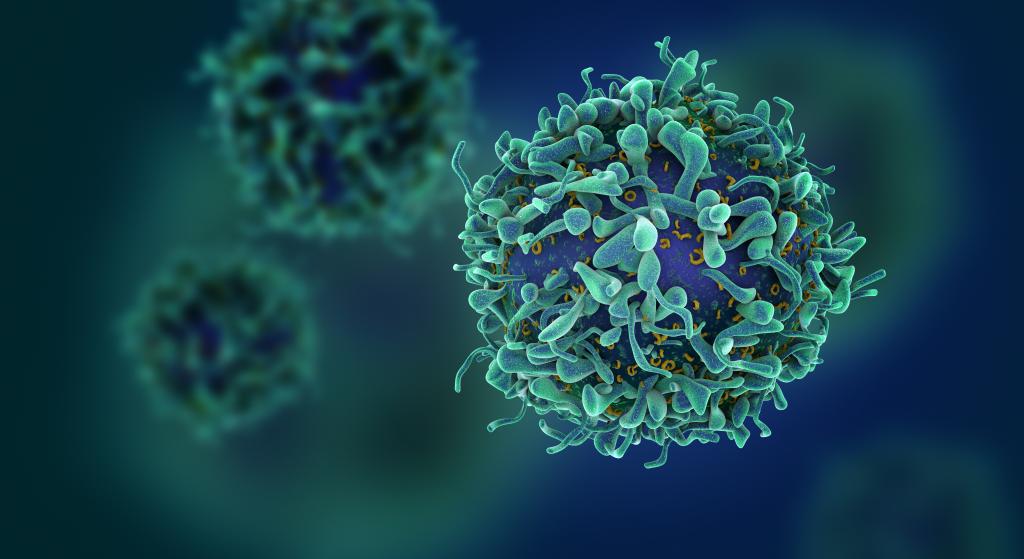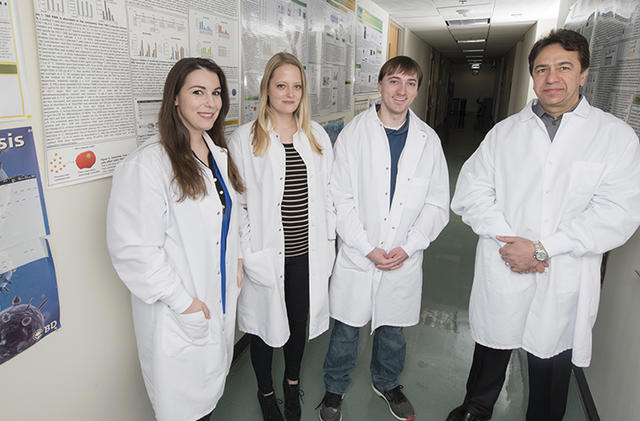Admission CTAs
Doctoral students' HIV and Ebola research scores high with the NIH
"The implications [of their work] are enormous," College of Science professor Fatah Kashanchi said.Catherine DeMarino, Alex Barclay, and Michelle Pleet were happy with the grant proposals they submitted to the National Institutes of Health, but they didn’t have any expectations.
The three doctoral candidates, all pursuing PhDs in biosciences at George Mason University, had completed their proposals to gain grant writing experience, and they were looking forward to seeing how they had done.
Writing grant proposals is often part of the daily life of many research scientists, but funding can be difficult to secure. The most prestigious opportunities—such as through NIH—are highly competitive.
So imagine their surprise when all three received extremely high scores that put them within the top 15 percent or higher of all applicants—and one of them, DeMarino, did so well that she actually received a perfect score of 10, which placed her in the top 3 percent of all applicants and landed her a nearly $75,000 grant to continue her research.
“We went into [submitting grants] seeing it as kind of a training,” said Pleet. “None of us really expected to get it.”
The recognition from NIH made perfect sense to College of Science professor Fatah Kashanchi, the principal investigator for the student research team.
“They don’t sit still,” he said of the three students. “In my mind, all three of them have been extremely successful. Their findings are not an independent silo. The implications [of their work] are enormous.”
Kashanchi has spent 24 years training fellow scientists and students in grant writing. In the BIOS 702 Research Methods course he teaches, the aim of the course is to prepare students for life after graduation by focusing on grant composition and the process by which grants are peer-reviewed.
All three students wrote their proposals based on the work they are doing in the field of microbiology and infectious diseases, specifically with HIV and the Ebola virus.
Extracellular vesicles (EVs) are particles that every person’s cells make, but they can reactivate the virus in HIV patients and cause inflammation, even if that person regularly takes antiviral drugs.
“Over time, when inflammation builds up, cells begin to die,” Barclay said. “So we’re thinking in context of the brain, and a lot of neurons are getting inflamed and dying that could certainly contribute to the dementia that patients see when they’re on the drugs for eight to ten years.”
Barclay has identified a protein in EVs that is responsible for reactivating HIV in long-term patients. He is currently running additional experiments to find out what that protein specifically does in a cell and how it affects other proteins.
DeMarino, who won a Ruth L. Kirschstein National Research Service Award Individual Predoctoral Fellowship, suspects that the current regimen of drugs that HIV patients take might contribute to how EVs help the virus in the brain. Working with samples from collaborators ranging from Nigerian hospitals to NIH to the National Institute on Aging, she is identifying drugs that can inhibit the process.
“What I’d like to eventually have is your antiretroviral traditional kind of regimen, and then find a compound that you can supplement that regimen with to stop this particular mechanism of pathogenesis.”
She will use the grant funding to continue her research, working at both NIH and at Mason.
Pleet’s work with Ebola virus proteins is groundbreaking, given that almost no one else in the field is looking at how EVs aid the virus in quickly spreading.
“The virus only targets specific cell types,” Pleet explained, “but there are other immune cells that do not get productively infected that [also] die out during infection, and people aren’t really sure why that is.”
Pleet has found that viral proteins in EVs may be responsible, and she is researching ways to stop that process and slow the spread of Ebola in an infected person.
All three are set to graduate in May, but that won’t stop their research. Barclay plans on going into industry, while both DeMarino and Pleet will work as post-doctoral fellows at NIH and continue the research they began at Mason.
According to all, the road to graduation has been difficult, but the camaraderie they have formed in the lab and the encouragement they have received from Kashanchi make it all meaningful.
“It’s tough being a PhD student. You don’t get a lot of sleep,” DeMarino said. “But if you have really great people around you, it makes it a little easier. Our team is fantastic.”
Topics: Impact, College of Science, bioscience, microbiology, Infectious Disease, Catherine DeMarino, Alex Barclay, Michelle Pleet, Fatah Kashanchi, HIV, Ebola Virus, extracellular vesicles, NIH grant funding, National Institutes of Health

